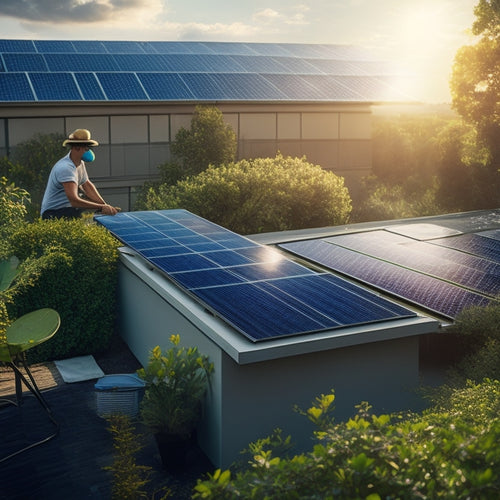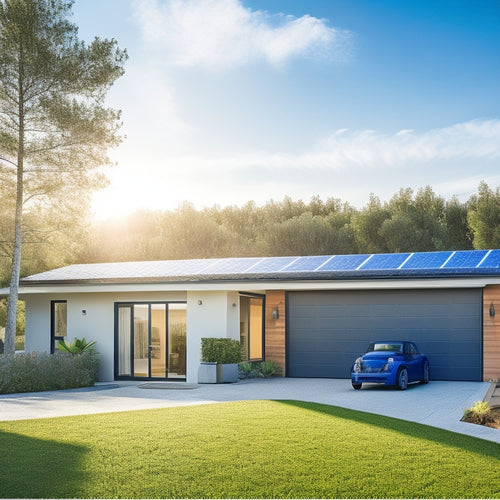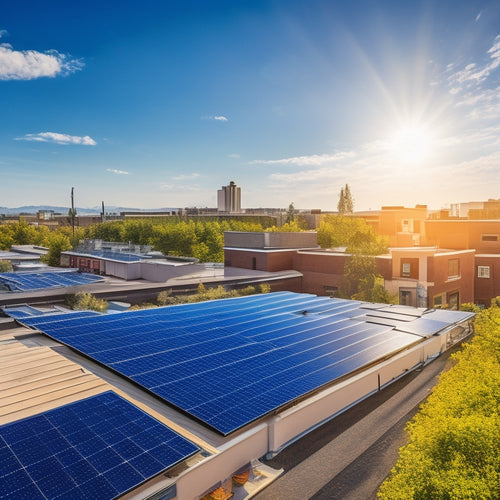
How to Switch to Solar Energy at Your Home in 5 Steps
Share
To switch to solar energy at your home in 5 steps, start by evaluating your energy needs, reviewing past utility bills to determine your average daily energy usage and total kWh per month. Next, choose a solar panel system that fits your energy needs, budget, and installation costs, considering factors like panel type, mounting system, and inverter technology. Then, prepare your home's roof by verifying its weight capacity, conducting a shading analysis, and removing debris obstructing sunlight. After that, install solar panels properly, obtaining necessary permits and connecting them to an inverter and net meter. Finally, monitor and maintain your system's performance, tracking energy production and consumption, and regularly cleaning and inspecting the panels to guarantee maximum efficiency, and that's just the beginning of your path to utilizing solar energy.
Key Takeaways
- Assess your energy needs by reviewing past utility bills and evaluating factors affecting energy usage to determine the right solar panel system size.
- Choose a solar panel system that fits your energy needs, budget, and installation costs, considering factors like panel type, mounting system, and inverter technology.
- Prepare your home's roof by verifying its weight capacity, conducting a shading analysis, and ensuring its structural integrity for safe and efficient installation.
- Install solar panels properly by obtaining necessary permits, securely fastening and connecting panels to an inverter, and connecting the system to a net meter.
- Monitor and maintain your solar panel system's performance by tracking energy production and consumption, scheduling regular cleaning and inspections, and addressing any issues promptly.
Assess Your Energy Needs
You'll need to determine how much energy your home consumes to determine the size of the solar panel system required. This involves calculating your energy consumption, which is typically measured in kilowatt-hours (kWh).
Review your past utility bills to get an idea of your average daily energy usage. Take note of the total kWh used per month and the peak sun hours in your area. This information will help you determine the size of the solar panel system needed to offset your energy consumption.
To get an accurate estimate, evaluate factors that affect your energy usage, such as the number of occupants, appliances, and lighting.
You may also want to assess energy-efficient upgrades to reduce your overall energy consumption. A lower energy consumption means a smaller solar panel system, which can lead to significant cost savings.
Choose a Solar Panel System
Choose a Solar Panel System
Three primary factors determine the type of solar panel system that's right for your home: the type and quality of solar panels, the mounting system, and the inverter technology.
You'll need to decide on the solar panel type that suits your energy needs and budget. There are two main solar panel types: monocrystalline and polycrystalline. Monocrystalline panels are more efficient but pricier, while polycrystalline panels are more affordable but less efficient.
The mounting system is also essential, as it affects the system's durability and installation costs. You can choose from roof-mounted, ground-mounted, or tracking systems. Roof-mounted systems are the most common, while ground-mounted systems offer more flexibility. Tracking systems follow the sun's movement, increasing energy production but at a higher cost.
Lastly, inverter technology converts DC power from the panels to AC power for your home. String inverters are the most common, but microinverters and power optimizers offer more flexibility and monitoring capabilities.
Consider your energy needs, budget, and installation costs when selecting a solar panel system.
Prepare Your Home's Roof
How much weight can your roof handle? Before installing solar panels, you need to verify your roof can support the added weight. Different roof materials have varying weight capacities, which affect the type and number of solar panels you can install.
| Roof Material | Weight Capacity | Suitable for Solar Panels |
|---|---|---|
| Asphalt Shingles | 2-3 pounds per square foot | Yes, but may require additional support |
| Clay or Concrete Tiles | 8-10 pounds per square foot | Yes, can support heavier solar panels |
| Metal Roofing | 1-2 pounds per square foot | Yes, ideal for solar panels |
| Slate Tiles | 8-10 pounds per square foot | No, too heavy for solar panels |
| Wood Shakes | 2-3 pounds per square foot | Yes, but may require additional support |
Conduct a shading analysis to identify areas on your roof that receive the most sunlight. This helps you determine the best placement for your solar panels. Remove any debris, such as leaves or branches, that may obstruct sunlight. Verify your roof is in good condition, and consider replacing it if it's old or damaged. A sturdy roof is essential for a safe and efficient solar panel installation.
Install Solar Panels Properly
With your roof prepared, it's time to focus on the installation itself. You'll need to decide on the type of solar panels that best suit your energy needs. There are two main solar panel types: monocrystalline and polycrystalline. Monocrystalline panels are more efficient but also more expensive, while polycrystalline panels are more affordable but slightly less efficient.
Once you've chosen your panels, make certain you obtain the necessary installation permits from your local authorities. This may include a building permit, electrical permit, and/or a permit from your utility company. Failure to obtain these permits can result in fines or even the removal of your solar panel system.
During installation, make sure the panels are securely fastened to your roof and connected to an inverter, which converts DC power to AC power for your home.
The installation team should also connect the system to a net meter, which tracks the excess energy you produce and feeds it back into the grid.
Monitor and Maintain Performance
As you begin generating solar energy, it's essential to keep a close eye on your system's performance to guarantee it's operating at its maximum capacity.
You'll want to track your system's performance metrics, such as energy production, consumption, and grid interaction. This data will help you identify any issues or areas for improvement.
To make sure your system runs smoothly, establish a maintenance schedule that includes:
-
Regular cleaning: Dust and debris can reduce your system's efficiency, so clean your panels regularly to maintain peak performance.
-
Inverter checks: Verify that your inverter is functioning correctly, as it's responsible for converting DC power to AC power for your home.
-
System inspections: Perform periodic inspections to identify and address any potential issues, such as loose connections or damaged components.
Frequently Asked Questions
Can I Install Solar Panels Myself to Save Money?
You can attempt a DIY installation to save on labor costs, but it's essential to weigh the risks: improper installation can void warranties, compromise efficiency, and even pose safety hazards, potentially offsetting any cost savings.
How Long Does It Take to Pay off My Solar Panel Investment?
You'll break even on your solar panel investment in 5-7 years, depending on your location and electricity rates, as you'll reap significant cost savings and investment returns through reduced energy bills and potential tax credits.
Do Solar Panels Work During Power Outages?
As you wonder if solar panels work during power outages, the answer hangs in the balance - and it's not a simple yes or no. Your solar panel efficiency is irrelevant if you don't have energy storage options, like batteries, to keep the power flowing.
Can I Sell Excess Energy Back to the Grid?
You can sell excess energy back to the grid through net metering benefits, which allow you to offset your energy consumption and receive credits or even revenue through energy buyback programs, depending on your utility provider's policies.
Will Solar Panels Increase My Home's Value?
You'll likely see an increase in your home's value with solar panels, as they increase home energy efficiency and provide long-term solar panel benefits, making your property more attractive to potential buyers and appraisers.
Conclusion
As you flip the switch to capture the power of the sun, you'll leave behind the pollution and unpredictability of traditional energy sources. Embracing solar energy means embracing a cleaner, more sustainable future. By following these 5 steps, you'll be generating your own electricity in no time. Contrast the freedom of solar power with the constraints of the grid, and you'll realize that switching to solar is a bright idea whose time has come.
Related Posts
-

Green Ways to Maintain Solar Panels
To maintain your solar panels sustainably, start with regular inspections to catch potential issues early, enhancing ...
-

Solar Energy Storage Options for Homes
When considering solar energy storage options for your home, you'll find several effective solutions. Battery systems...
-

Solar Energy Solutions for Small Businesses
Switching to solar energy can be a game changer for your small business. You'll enjoy significant cost savings on mon...


